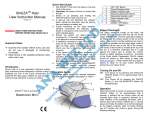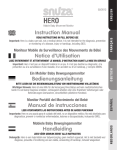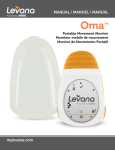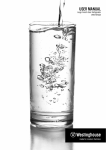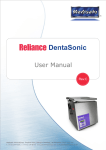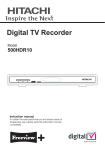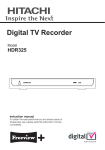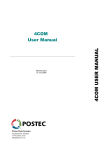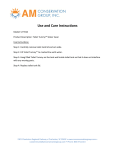Download User Instruction Manual
Transcript
IMPORTANT NOTICE PLEASE READ THIS User Instruction Manual Your Snuza monitor has its sensor in the coloured flexible plastic tip. In order for Snuza to detect the breathing movement of your baby this sensor MUST always be in contact with baby’s skin in the tummy area where breathing movement occurs. If Snuza is switched on and this contact is lost then the Snuza will sound an alarm. Therefore to prevent unnecessary false alarms through lack of contact please 10/2008 READ INSTRUCTIONS IN FULL BEFORE OPERATING SNUZA HALO IMPORTANT NOTES • Snuza Halo is not a medical device. • Use the correct size nappy. • The nappy must fit snugly without gaping. • The sensor MUST maintain contact with baby’s tummy at all times. ALWAYS: A 5 Ensure that Snuza sits squarley on the nappy, and that the sensor is in contact with baby’s skin. B If the above procedure is always properly followed, you can be sure that your baby’s breathing movement is being monitored, and false alarms caused by lack of contact between the sensor and baby’s skin will be prevented. NOTE: 3 Ensure that the nappy adjusters are used to provide a snug fit in the tummy area. (Image B) ~2~ Introduction User Interface Placement Snuza Halo safely and conveniently monitors your baby’s breathing movement. Being completely mobile, it means protection and peace of mind anywhere and everywhere. The patented technology monitors the movement of baby’s tummy as it breathes, and it contains a built-in vibrator stimulator to gently rouse the baby if a 15 second period of no breathing movement is detected. If breathing movement is not detected for a further 5 seconds, an alarm will alert you to act. The image below shows the relevant indicators and buttons itemised with a description in Table 1: 3 Snuza Halo must be clipped onto the nappy all the way so that the top edge of the nappy (which should be folded) presses up against the clip attachment point. The monitor must be positioned so that the sensor (4) is in contact with the baby’s tummy. The best position to detect breathing movement is around the belly button area although closer to the sides may suit different sleeping positions. You may need to experiment to find the best position that maintains contact with baby’s tummy. As recommended by the World Health Organisation (WHO) in order to reduce the incidence of SIDS or “cot death”, please ensure that your baby is placed to sleep on its back unless advised otherwise by your baby’s doctor. 4 Turning On and Off Quick Start Guide 6 Then press the on switch, whereupon monitoring will comence. 1 Use the correct size nappy. A nappy that is too large might be too loose around the tummy area, causing Snuza to lose contact. 2 Fold the waistband or top of the nappy over to create a double fold, giving Snuza a firm grip on the nappy. (Image A) 4 Firmly clip Snuza onto the folded nappy waistband, using the full extent of the clip. Handle Snuza with care to prevent damage to clip or Sensor. ~3~ 1. 2. 3. 4. 5. 6. 7. 8. 9. Important: Use the correct nappy size and make sure it fits snugly. See Nappy Fitment. Switch on by briefly pressing the ON/OFF button (1). A start-up test will illuminate the indicator lights, vibrate the stimulator, play the start-up tone and perform a battery test. Clip Snuza Halo onto the nappy so that the sensor (4) is in contact with the baby’s tummy. Movement of baby’s tummy is monitored as it breathes. Each breath is indicated by a green flash of the movement indicator light. If breathing movement is not detected for 15 seconds, the vibrator stimulator will attempt to rouse baby to resume breathing movement. The movement indicator light will flash yellow instead of green if further movement is detected. If the period of no breathing movement reaches 20 seconds, the alarm will be activated. The alarm indicator light will flash red in conjunction with the siren-like audible alarm. Note that resuscitation may be required. See Alarm on pg 8. To turn off the monitor, both the MODE/OFF and ON/OFF buttons must be pressed simultaneously. A shutdown tone will be heard. ~4~ 1 2 8 7 Table 1 6 5 5 Movement Indicator Light 6 Alarm Indicator Light 7 Nappy Clip 8 MODE / OFF Button 1 ON / OFF Button 2 Sound Emission Hole 3 Battery Indicator Light 4 Breathing Movement Sensor Nappy Fitment Important: Correct nappy fitment is essential for the operation of Snuza. The thin flap of material at the top of the nappy must be folded over the thicker part before the nappy is closed (this is the section that Snuza Halo will be attached to). The nappy should fit snugly on the baby with the top of the nappy just below the belly button. Loose fitting nappies will gape, causing the monitor to lose contact with the skin and false alarm. A very ‘full’ or wet nappy may also cause nappy to gape. ~5~ ON: Turn on by briefly pressing the ON/OFF Button (1). OFF: Turn off by pressing the ON/OFF Button (1) and the MODE/OFF Button (8) simultaneously. Operation When turned on (press and hold the ON/OFF button (1) for approximately half a second), a startup-test will run which will turn on (in sequence) all indicator lights, the vibration stimulator and the audible alarm. After the startup test there is a 1 second pause followed by the battery level being indicated by briefly flashing the Battery Indicator Light (3). The colour of the indicator light has the following meaning: Battery OK Battery nearing depletion Battery flat – do not use Warning: Careful attention must be paid during the self test to ensure all lights, vibrator and alarm are working properly and that the ~6~ battery level is high enough for proper operation (ie green or yellow light). Otherwise, DO NOT use the monitor. If the battery is too flat to operate, the battery indicator light will flash red accompanied by a short beep every second. You will not be able to use the monitor in this case. Monitoring Once the startup test completes, monitoring mode commences. During monitoring mode, the Movement Indicator Light (5) will briefly illuminate1 as the baby’s breathing movements are detected. Snuza Halo is equipped with a vibrator stimulator which is used in an attempt to rouse the baby after 15 seconds of no breathing movement. If there is no breathing movement detected for a further 5 seconds, the audible alarm will be activated together with the red flashing Alarm Indicator Light (6). If breathing movement is detected before 20 seconds pass, the Movement Indicator Light (5) will change colour from green to yellow. This can be used to determine if Snuza Halo successfully roused the baby. After the third time the baby has been successfully roused, the time before vibration will be extended to 20 seconds, coinciding with the activation of the audible alarm and accompanying Alarm Indicator Light (6). When the alarm is activated, it will continue until it is reset by either turning Snuza Halo off completely (by pressing ON/OFF and MODE/OFF buttons simultaneously), or to continue monitoring, by briefly pressing the MODE/OFF button (8). Important: In the event of an alarm, check the baby’s vital signs and initiate the appropriate medical attention if necessary. See Alarm on pg 8. If the battery nears depletion during monitoring mode, the Battery Indicator Light (3) will begin to flash red. This is a warning that the battery will soon be depleted. If the battery becomes depleted during monitoring mode, the low battery alarm will sound. This is characterised by a flashing red Battery Indicator Light (5) and a simultaneous beep every 2 seconds. The monitor must not be used and be immediately taken out of service. Modes of Operation During monitoring, the MODE/OFF button (8) has the following functionality: Briefly (for less than 1 second) pressing the MODE/OFF button will allow an audible ‘tick’ to be heard on each breath. The tick volume has 3 levels and can be increased by pressing the mode button until the desired volume is reached. The tick function is turned off by pressing the MODE button a fourth time, indicated by a lower tone beep. This feature may be used to audibly verify breathing movement either locally or remotely if used together with a baby sound monitor. Pressing and holding the MODE/OFF button (8) for 1 second will enable the rouse warning feature. This feature gives an audible warning when the baby has been successfully roused 3 times since turning on. This warning is characterised by a flashing yellow Movement Indicator Light (5) and a beep every 2 seconds. Snuza Halo can either then be switched off, or by briefly pressing the MODE/OFF button you will silence the alarm and reset this alarm mode to its initial active state. to ensure breathing is restored. In some cases, simply picking up a baby that has stopped breathing is all that’s required to recommence breathing. In serious cases CPR (Cardio Pulmonary Resuscitation), or Rescue Breathing may be required and must be immediately administered. It is recommended that learning how to apply CPR is essential for caregivers of babies with known breathing abnormalities. This knowledge is available on the internet (Google CPR or “Rescue Breathing” for information) or by attendance at CPR or Rescue Breathing training courses. False Alarms False alarms are unnecessary and stressful, and may be avoided by making sure that the instructions herein, headed IMPORTANT NOTICE, are strictly adhered to. The basic requirement to avoid false alarms is to ensure that the flexible sensor (4) remains in contact with baby’s skin near the tummy area at all times during monitoring. If contact is lost, a false alarm will sound. False alarms also shorten battery life and must be avoided. Travelling Snuza Halo’s sensor detects movement, and therefore when baby is subjected to a lot of movement, such as being pushed in a pram or traveling in a car or aircraft, it’s possible that baby’s movement from these non-breathing sources will be detected. Therefore, Snuza Halo may not be able to differentiate between such externally created movement and breathing movement. For this reason, Snuza Halo should not be relied upon where external sources of movement are present. Baby Sound and Video Monitors (Optional) minimum period between flashes is 1 second for the first 5 minutes of monitoring (after turning on). Thereafter, the minimum flash period becomes 3 seconds, i.e. the breathing indicator will only flash at least every 3 seconds even if breathing is at a higher rate than this. As described under Monitoring, Snuza Halo will sound an alarm if it does not detect breathing movement for a period of 20 seconds. Should the alarm sound because breathing has ceased, immediate emergency action is vital Snuza Halo can be used together with a baby sound or video monitor to extend the distance at which the alarm can be heard. Make sure the effectiveness to hear the monitor has been tested before using it in this way. It is highly recommended to use a sound monitor that alerts you when out of range or if there is an error with communication. If not there is an ~7~ ~8~ ~9~ 1 The Alarm increased risk that the audible alarm from Snuza Halo will not be relayed. Precautions • Do not insert anything into the Sound Emission Hole (2) as damage to the device may result. • Do not allow any liquid to enter the Sound Emission Hole (2). • Avoid bending the sensor unnecessarily. • Do not use undue force to bend the clip. The clip can easily with- stand deforming to accommodate the natural thickness of the nappy but excessive bending may cause it to permanently deform. Cleaning significantly if the average daily duration of use and/or alarm duration and/or number of alarms is different from this. Turning Snuza Halo on and off unnecessarily will prematurely deplete its battery life. If the number of alarms is high, it is essential to check the nappy fitment and to make sure Snuza Halo is fitted correctly in order to prevent premature battery depletion. If these steps have been taken and the number of alarms is still high, please consult your baby’s doctor immediately. Factory Battery Replacement Biosentronics offers a factory fitted battery replacement service. Please visit our website on www.snuza.com for further details. Should the monitor become soiled, gently wipe with a damp cloth to remove any dirt. A mild soap may be applied to the cloth for stubborn dirt. Do not use any other cleaning agent as they may contain damaging chemicals. The monitor is splash resistant, not waterproof. Do not immerse in water. If it gets wet, dry it off immediately. Disposal Storage When lifting baby out of the cot to feed (or comfort, etc.), the position that the baby is held in may cause the monitor to lose contact with the skin which will result in the alarm going off. To prevent this, it is recommended that the monitor be repositioned so that the Sensor maintains contact with baby’s skin. When not in use, place the monitor in the protective case for safe storage. Do not store in a damp area as it may affect the monitor and cause it to malfunction. Dressing The monitor can be used if baby is dressed in light clothing (for example, a Babygro) but too much clothing may attenuate or muffle the alarm. Make sure the alarm can be heard if baby is covered in clothing and/or blankets. Snuza Halo may be returned to Biosentronics for proper disposal. Otherwise it must be disposed of in accordance with your country’s laws governing the disposal of Li-SOCl2 batteries. Please visit our website for further information on these and other troubleshooting issues. Disclaimer The Snuza Halo Baby Movement Monitor is a baby-care aid, not a medical device. It is intended for use under safe operating conditions and must be used responsibly and in accordance with the detailed instructions appearing in this SNUZA Instruction Manual. Babies with a known predisposition to any breathing abnormality including apnoea should be monitored by a doctor. Customers use this monitor at their own risk and Biosentronics cc, its members, employees, agents, contractors, representatives, manufacturers, distributors and associates (“SNUZA”) shall not be held liable for any loss, damage or injury suffered by the customer or any other person arising from, or in connection with, the use or manufacture of the monitor, including loss, damage or injury suffered by the customer or any other person as a result of any defects in respect of the monitor, and all warranties, and any other liability from whatsoever cause arising, are hereby excluded and the customer hereby indemnifies Biosentronics cc in respect of any such liability. Guarantee Useful Tips Troubleshooting The non-replaceable battery will last approximately 12 months if used on average 6 times per day for a total of 18 hours per day and with 1 alarm per day lasting no longer than 20 seconds. The battery life will vary Snuza Halo is a reliable and tested electronic device, and any failure to function correctly is likely to be caused by: 1. Incorrect fitment and placing of Snuza on baby’s nappy (read Nappy Fitment and Placement in these instructions). 2. Not ensuring that points 1 to 5 in the IMPORTANT NOTICE section of these instructions are strictly followed to ensure that the sensor (4) is always in contact with baby’s skin. ~10~ ~11~ Battery Life 3. Battery failure. The battery indicator light (3) will show red in colour. See Factory Battery Replacement. Biosentronics guarantees this product to be free from defects in materials and workmanship for a period of 12 months from the original date of purchase, verified by a sales receipt, and provided that such 12 month period is within 3 years of the date of manufacture, as recorded on the product rear label and original packaging. Our guarantee liability shall be limited to replacing the unit free of charge and does not include transport costs. Our guarantee extends to all countries in which this product is supplied. By the act of operating this product, the user accepts all resulting liability. We reserve the right to modify the provisions of this guarantee at any time without notice. This guarantee does not cover incorrect application, tampering, misuse or transport damage. SNUZA is a registered trademark of Made in South Africa Patented ~12~


